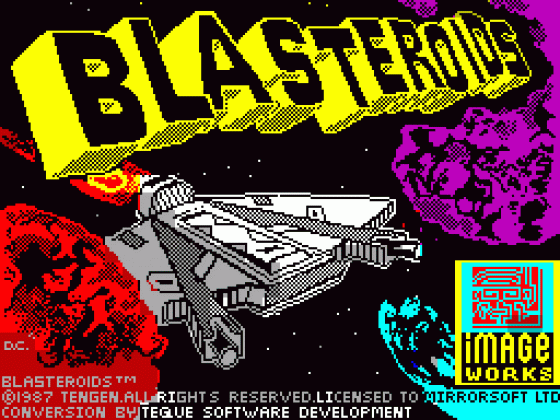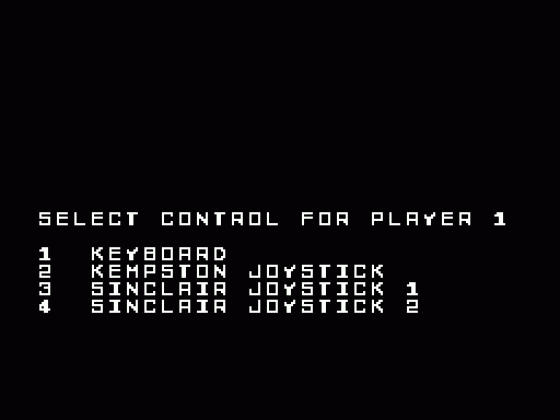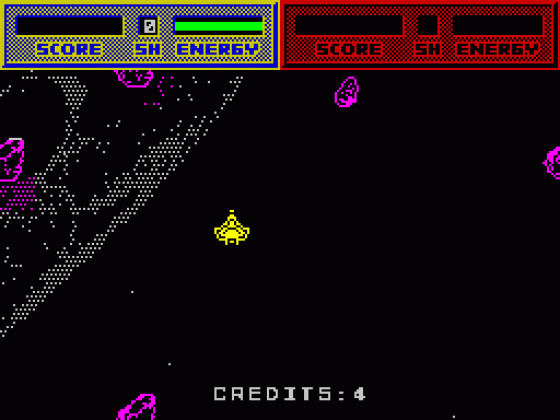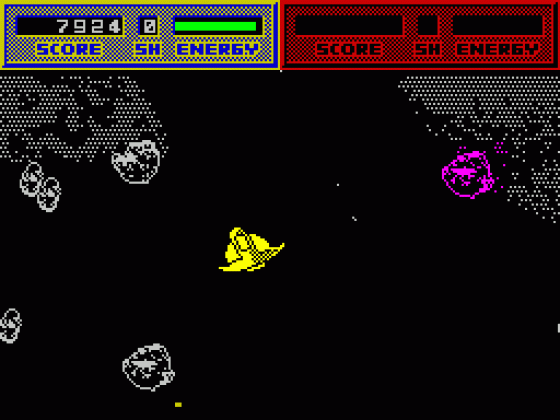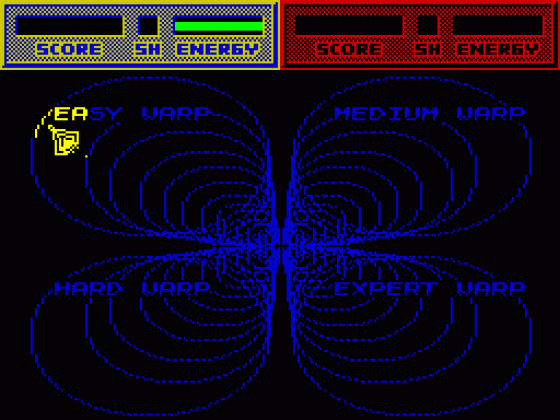
C&VG
 1st March 1989
1st March 1989
Categories: Review: Software
Publisher: Image Works
Machine: Spectrum 48K/128K
Published in Computer & Video Games #89
Blasteroids
Blasteroids' roots go all the way back to 1979 to a video game called, surprisingly enough, Asteroids. It was actually quite innovative for the time, taking the left/right/thrust/fire/hyperspace controls of the earlier vector graphic game Space Wars and putting the player in the middle of an asteroid storm. The objective was simple: blast the rocks and occasional spaceship (known affectionately as the "eggles" because of their shape) and survive.
The 1988 version (the machine appeared last year) follows a similar concept, but adds nearly a decade's worth of new technology to breathe new life into the ageing format.
One of the major changes is the addition of a one- or two-player option, allowing a team of prospective rock wreckers to battle together. The rocks in question are colourful bits of debris that break down under fire twice, each part getting smaller until it's tiny enough to vapourise.

Destroying rocks is the key issue, because if one strikes the ship its shield, represented at the top of the screen by a diminishing bar, shrinks towards a fatal zero. The player(s) start with three credits, effectively giving three lives.
The ships are the apex in space boulder demolition hardware, and are capable of transforming into three different sizes. Small ships are very manoeuvrable, but suffer from a low shield and firepower. Medium ships have heavy firepower, but medium speed and shields, while large ships are slow and have medium firepower, but are well-shielded.
In two-player mode the two ships can join together - one player controls the large and manoeuvrable main ship while the other takes control of a gun turret at the top. It's an unusual feature, and one which I found very enjoyable (as well as argument-inducing if you've got an idiot in control of the main ship!)
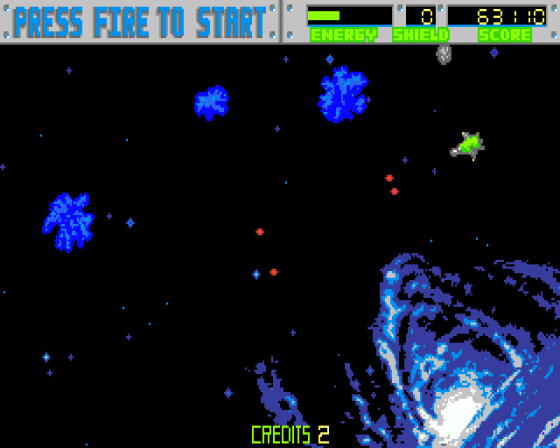
At the start of a game one of four difficulty levels is chosen: normal, medium, hard or expert. Bonus points are given if the player elects to start on a higher level. The action then begins with the ships being placed in the first asteroid storm, and the blasting starts.
There are several different kinds of rocks. Grey ones simply vaporise when shot, while red ones drop glowing energy crystals which are picked up to replenish shield levels. Later on, blue popcorn asteroids appear and drift around the screen until they're shot four times, whereupon they stop and form an unmovable obstacle. The final asteroid type is a deodesic, which homes in on the ship when shot, forcing the player to take evasive action and blast it again and destroy it before it hits home.
When a screen is cleared of rocks, an exit portal appears, which the ships fly into to take them to the main menu where another screen is selected.
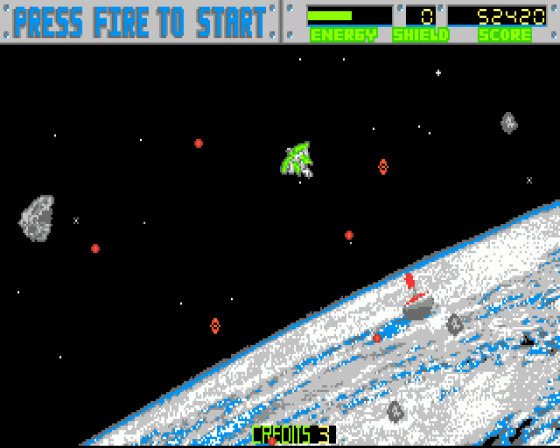
As the players progress further into the game, alien spaceships enter the fray and attempt to shoot down the ships, or simply crash into them and damage their shields. Fortunately, they can be shot, and sometimes a power-up item is dropped, which can be collected to add an extra feature to the ship. Such goodies include extra shield energy capacity, double shot power, magnets (which attract energy crystals), shields (which give the ship extra protection), extra hit power, speed-up, ripstar (a sort of smart bomb) and cloak.
Occasionally space leeches are discovered. These horrors reside in eggs and are released when the shell is shot, whereupon they head directly for the ship and attempt to attach themselves to the outer hull and suck its shield energy dry. Naturally, the onus is on blasting them before they get close.
When sixteen screens are cleared, Mucor appears. He's a giant green alien who marauds around the screen, shooting out tiny aliens from his nodules and trying his utmost to bash the ships, which diminishes shields considerably. The only way to destroy him is by blasting his nodules, which requires repeated and accurate fire. When he's destroyed it's off to a tougher set of asteroid fields populated by an even more aggressive group of aliens.
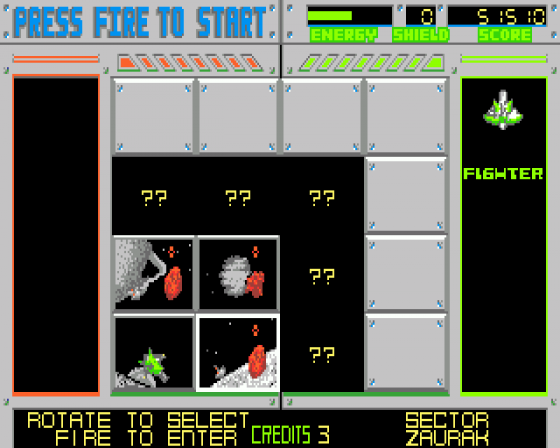
Being a great fan of the coin-op, I've been eagerly awaiting this for some time, and I'm glad to say the wait has been worth it. The ST version is brilliant, and fully captures the spirit and frantic action of the original machine. All the features of the coin-op have been incorporated, and I mean *all* of them, and the game plays in exactly the same way, so arcade players can use all of their favourite tactics.
The only disappointments are the gaudy backdrops (the sprites are excellent, though) and the mediocre sound. But I suppose you can't have everything. Still, the gameplay is adrenalin pumping, and Blasteroids is easily the best Atari ST shoot-'em-up to date.
Spectrum owners are also in for a treat. That too has all the features of the original, and even if the gameplay is a little on the slow side, it's still very playable, especially in two-player mode.
Blasteroids is superb on both the ST and Spectrum - hopefully future Image Works arcade conversions will be of a similar high quality.
Scores
Atari ST Version| Graphics | 81% |
| Sound | 53% |
| Value For Money | 82% |
| Playability | 93% |
| Overall | 90% |
Scores
Spectrum 48K/128K Version| Graphics | 81% |
| Sound | 53% |
| Value For Money | 82% |
| Playability | 93% |
| Overall | 90% |




